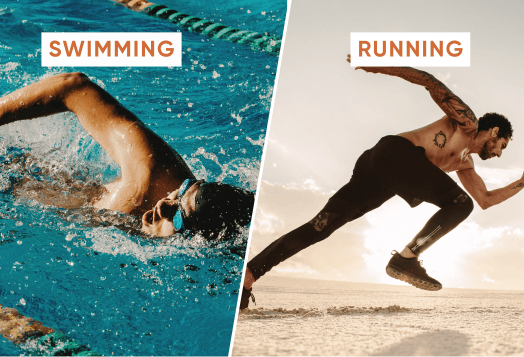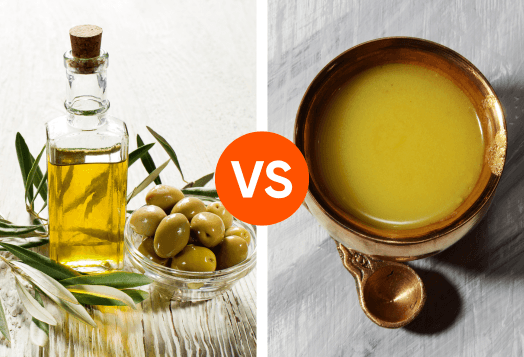
The age-old fitness debate continues: Should you hit the pool or pound the pavement?
If you're trying to lose fat and get fit, both swimming for weight loss and running offer incredible benefits.
But here's the truth – you don't have to choose just one. Let's dive deep into the science behind swimming & running, and discover why combining them might be your secret weapon for fat loss and fitness.
The Calorie Burning Battle
When it comes to pure calorie burn, the numbers tell an interesting story. According to Harvard Health Publishing research, here's how these two powerhouse exercises stack up:
Calorie Burn Comparison (30 Minutes, Moderate Intensity)
Body Weight | Swimming (General) | Running (6 mph) (10 min/mile) |
125 lbs | 180 calories | 300 calories |
155 lbs | 216 calories | 372 calories |
185 lbs | 252 calories | 444 calories |
Source: Harvard Health Publishing, 2021
The Verdict: Running wins the calorie-burning race, especially at higher intensities. But before you lace up those running shoes exclusively, let's look at the bigger picture.
Fat Loss Is Not Just About Calories
While calorie burn matters, fat loss is more complex than simple math. When you work out, your metabolism doesn’t just shut off the moment you stop moving. There's a phenomenon called Excess Post-Exercise Oxygen Consumption (EPOC), a scientific way of saying your body continues burning calories even after you're done.
Here are some cool insights about how these exercises affect your body composition.
Running, Swimming and Fat Loss
One study published in the International Journal of Exercise Science compares two kinds of workouts, circuit-style resistance training (RT) and high-intensity interval training (HIIT), on fit women to see which spikes metabolism longer.
Both workouts raised calorie burn for up to 14 hours post-exercise, but circuit training had a slight edge. At the 24-hour mark, RMR (Resting Metabolic Rate) levels dropped back down for both, but RT still offered a longer-lasting metabolic boost.
So what does that mean for swimming vs running? Both are great for burning calories during the workout. But if you structure them with resistance or interval training, like hill runs, you can amplify that afterburn. And if you add in strength training (like pool resistance moves), you’re likely to see even better results for fat loss and muscle tone.
In short, don’t just chase the calorie burn during your workout. Train in a way that keeps your body burning long after you towel off.
Health Benefits Beyond Fat Loss
There’s more to fitness than just shedding kilos. Here’s what these workouts offer beyond the scale.
1. Cardiovascular Health: It's a Tie
Both exercises are cardiovascular champions. The American Heart Association research shows that both swimming and running:
Lower resting heart rate
Reduce blood pressure and improve circulation
Improve VO2 max (oxygen efficiency)
2. Joint Health: Swimming Takes the Crown
This is where swimming shines brightest, especially when introducing swimming for kids. According to the Arthritis Foundation, swimming laps has been shown to reduce pain and improve joint function in people with inflammatory arthritis.
In case of running, every time your foot hits the ground, it sends a force through your lower body, typically 2 to 3 times your body weight, and this force is essential for bone remodelling and joint adaptation.
Running trains your joints to handle load, while swimming trains them to move freely without stress.
So, which is better? It depends on your current joint status and fitness goals.
Goal & Condition | Suggestion |
| Running (adds load, builds bone density) |
| Swimming (zero impact, joint-friendly) |
| Swimming first, then land training like brisk walking or light running |
| A mix of swimming for pain-free movement, and light impact activities like walking, to prevent osteoporosis |
3. Bone Health: Running Fights Back
Here's where running reclaims its advantage. The National Institute of Health confirms that a combination of resistance exercises and weight-bearing aerobic exercises like running stimulates bone density improvement, while swimming (being non-weight-bearing) doesn't provide this benefit.
4. Mental Health: Both Win Differently
Mental Benefits from Swimming:
The rhythmic breathing and meditative nature may help reduce anxiety
The cooling effect helps regulate stress hormones
Social swimming environments boost mood as well
Mental Benefits from Running:
The famous "runner's high" from endorphin release
Outdoor running provides vitamin D and nature exposure benefits
Achievement-oriented goals (races) boost confidence
Critical Factors To Consider
No one wants a workout that leads to a week on the couch. Here are a few factors you should consider before starting:
1. Injury Rate
Running Injury Rates: Research from the Journal of Sports Medicine shows that 37-56% of recreational runners experience an injury annually.
Common issues include:
Knee pain and runner's knee
Shin splints
Plantar fasciitis
IT band syndrome
Swimming Injury Rates: Swimming boasts significantly lower injury rates as compared to other sports. In fact, swimming is known as a great cross-training option for better rehab. Most swimming injuries are overuse-related and affect:
Shoulders (swimmer's shoulder)
Lower back
Neck strain
The Bottom Line: You're more likely to get injured running than swimming.
2. Accessibility and Practicality
Even the best workout won’t work if it’s hard to stick with. Let’s see which of these two is easier to fit into your daily routine:
Aspect | Running | Swimming |
Advantages | • No equipment needed • Done anywhere, anytime • Free after shoes • Quick workouts possible | • Weather-proof (indoor pools) • Full-body workout • Great for all levels• Cooling & refreshing |
Biggest Challenges | • Harder on beginners • Outdoor weather dependency | • Needs pool access • May need technique training • Pool fees/travel • Chlorine sensitivity |
The Beginner's Dilemma: Which Should You Choose?
Here's where the sky becomes clear – you don't have to choose. In a study with 30 regular runners, those who added swimming to their weekly routine improved their run times just as much as those who added more running. Interestingly, the group that kept doing only their usual running didn’t see much progress.
This study concludes that non-specific training, like swimming, enhances running performance in well-trained recreational runners.
Your Perfect Swimming vs Running Combination Plan
Week | Day | Workout | Details |
1–4 | Monday | Easy Running | 20-min gentle jog Focus on form Walk breaks as needed |
Tuesday | Swimming Basics | 10-min easy swim Try different types of swimming techniques 4 × 25m with rest | |
Wednesday | Rest / Gentle Walk | Let your body recover | |
Thursday | Running Intervals | 5-min warm-up 6 × 1-min run/1-min walk 5-min cool-down | |
Friday | Swimming Variety | 15-min mixed strokes Use kickboard & pull-buoy | |
Weekend | Freestyle Choice | Pick your favorite or try both again | |
5–8 | Monday | Tempo Running | 25-min at “comfortably hard” pace Talk in short sentences |
Tuesday | Swimming Intervals | 5-min warm-up 8 × 50m with 30-sec rest 5-min cool-down | |
Wednesday | Cross-training or Rest | Optional low-impact movement (yoga, walk, bike) | |
Thursday | Running Hills/Stairs | 20-min with hill/stair repeats Builds strength | |
Friday | Swimming for Weight Loss | 30-min continuous Change strokes every 100m | |
Weekend | Long Slow Session | Swim or run at easy pace, go longer! | |
9–12 | Flexible | Performance Phase | Increase duration, intensity, or both Listen to your body |
Note for Seniors or Those with Injuries: If running feels too intense, start with a Swimming + Walk combo. Try walking 15–20 minutes at a gentle pace on land or in water, followed by easy strokes in the pool. Even light movement creates big results over time—comfort comes first, consistency second.
Strategy To Maximise Weight Loss
Nutrition timings are very important for both activities. Research from the International Society of Sports Nutrition suggests the following optimal fueling strategies:
Pre-Exercise (1-2 hours before):
Light carbohydrate snack (banana, toast)
Adequate hydration
Post-Exercise (within 30 minutes):
Protein + carbohydrate combination
3:1 or 4:1 carb-to-protein ratio optimal
Note:
Studies show that swimming can increase appetite more than running due to water temperature effects on metabolism, different hormone responses, and psychological "reward" eating. It is also known as ‘The Swimming Appetite Phenomenon’. So, it’s important to plan your post-swim nutrition carefully and track portions initially.
The Final Verdict: Why Both Win
Swimming and running together offer better results than either alone, especially for beginners. While running strengthens the lower body and builds bone density, swimming supports the upper body and provides a joint-friendly way to stay fit. This combo enhances cardiovascular health, prevents overuse injuries, and keeps workouts interesting year-round.
You can alternate between the two based on weather or energy levels, making fitness feel less like a chore. Need a nudge? Pyng’s certified swimming trainers can help you get started with the right form and confidence.
Your fitness journey doesn’t need to choose—it can do both.




